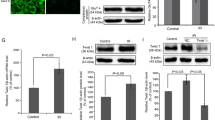Abstract
NYGGF4 is a recently discovered gene that is involved in obesity-associated insulin resistance. The exact mechanism by which NYGGF4 induces insulin resistance has not yet been fully elucidated. In this study, we demonstrated that the overexpression of NYGGF4 in 3T3-L1 adipocytes decreased mitochondrial mass, mitochondrial DNA, and intracellular ATP synthesis. In addition, NYGGF4 overexpression also led to an imbalance of the mitochondrial dynamics and excess intracellular ROS production. Collectively, our results indicated that the overexpression of NYGGF4 caused mitochondrial dysfunction in adipocytes, which might be responsible for the development of NYGGF4-induced insulin resistance.





Similar content being viewed by others
References
Jeffery RW, Sherwood NE (2008) Is the Obesity epidemic exaggerated? No. BMJ 336:244–246
Walley AJ, Asher JE, Froguel P (2009) The genetic contribution to non-syndromic human obesity. Nat Rev Genet 10:431–442
Qiu J, Ni YH, Gong HX et al (2007) Identification of differentially expressed genes in omental adipose tissues of obese patients by suppression subtractive hybridization. Biochem Biophys Res Commun 352:469–478
Wang B, Zhang M, Ni YH et al (2006) Identification and characterization of NYGGF4, a novel gene containing a phosphotyrosine-binding (PTB) domain that stimulates 3T3-L1 preadipocytes proliferation. Gene 379:132–140
Caratù G, Allegra D, Bimonte M et al (2007) Identification of the ligands of protein interaction domains through a functional approach. Mol Cell Proteom 6:333–345
Zhang CM, Chen XH, Wang B et al (2009) Over-expression of NYGGF4 inhibits glucose transport in 3T3-L1 adipocytes via attenuated phosphorylation of IRS-1 and Akt. Acta Pharmacol Sin 30:120–124
Kim JA, Wei Y, Sowers JR (2008) Role of mitochondrial dysfunction in insulin resistance. Circ Res 102:401–414
Maasen JA (2008) Mitochondria, body fat and type 2 diabetes: what is the connection? Minerva Med 99:241–251
Rong JX, Qiu Y, Hansen MK et al (2007) Adipose mitochondrial biogenesis is suppressed in db/db and high-fat diet–fed mice and improved by rosiglitazone. Diabetes 56:1751–1760
Wilson-Fritch L, Nicoloro S, Chouinard M et al (2004) Mitochondrial remodeling in adipose tissue associated with obesity and treatment with rosiglitazone. J Clin Invest 114:1281–1289
Choo HJ, Kim JH, Kwon OB et al (2006) Mitochondria are impaired in the adipocytes of type 2 diabetic mice. Diabetologia 49:784–791
Kelley DE, He J, Menshikova EV et al (2002) Dysfunction of mitochondria in human skeletal muscle in type 2 diabetes. Diabetes 51:2944–2950
Morino K, Petersen KF, Dufour S et al (2005) Reduced mitochondrial density and increased IRS-1 serine phosphorylation in muscle of insulin-resistant offspring of type 2 diabetic parents. J Clin Invest 115:3587–3593
Hammarstedt A, Jansson PA, Wesslau C et al (2003) Reduced expression of PGC-1 and insulin-signaling molecules in adipose tissue is associated with insulin resistance. Biochem Biophys Res Commun 301:578–582
Dahlman I, Forsgren M, Sjogren A (2006) Downregulation of electron transport chain genes in visceral adipose tissue in type 2 diabetes independent of obesity and possibly involving tumor necrosis factor-alpha. Diabetes 55:1792–1799
Schrauwen P, Hesselink MK (2004) Oxidative capacity, lipotoxicity, and mitochondrial damage in type 2 diabetes. Diabetes 53:1412–1417
Kaaman M, Sparks LM, van Harmelen V et al (2007) Strong association between mitochondrial DNA copy number and lipogenesis in human white adipose tissue. Diabetologia 50:2526–2533
Maxwell DP, Wang Y, McIntosh L (1999) The alternative oxidase lowers mitochondrial reactive oxygen production in plant cells. Proc Natl Acad Sci USA 96:8271–8276
Robin ED, Wong R (1988) Mitochondrial DNA molecules and virtual number of mitochondria per cell in mammalian cells. J Cell Physiol 136:507–513
Scorrano L (2007) Multiple functions of mitochondria-shaping proteins. Novartis Found Symp 287:47–59
Bonnard C, Durand A, Peyrol S et al (2008) Mitochondrial dysfunction results from oxidative stress in the skeletal muscle of diet-induced insulin-resistant mice. J Clin Invest 118:789–800
Spiegelman BM (2007) Transcriptional control of mitochondrial energy metabolism through the PGC1 coactivators. Novartis Found Symp 287:60–63
Lowell BB, Shulman GI (2005) Mitochondrial dysfunction and type 2 diabetes. Science 307:384–387
Guilherme A, Virbasius JV, Puri V et al (2008) Adipocyte dysfunctions linking obesity to insulin resistance and type 2 diabetes. Nat Rev Mol Cell Biol 9:367–377
Chan DC (2006) Mitochondria: dynamic organelles in disease, aging, and development. Cell 125:1241–1252
Chen H, Chomyn A, Chan DC (2005) Disruption of fusion results in mitochondrial heterogeneity and dysfunction. J Biol Chem 280:26185–26192
Santel A, Frank S (2008) Shaping mitochondria: The complex posttranslational regulation of the mitochondrial fission protein DRP1. IUBMB Life 60:448–455
Brown GC (1992) Control of respiration and ATP synthesis in mammalian mitochondria and cells. Biochem J 284:1–13
Puigserver P, Wu Z, Park CW et al (1998) A cold-inducible coactivator of nuclear receptors linked to adaptive thermogenesis. Cell 92:829–839
Fridlyand LE, Philipson LH (2006) Reactive species and early manifestation of insulin resistance in type 2 diabetes. Diabetes Obes Metab 8:136–145
Houstis N, Rosen ED, Lander ES (2006) Reactive oxygen species have a causal role in multiple forms of insulin resistance. Nature 440:944–948
St-Pierre J, Drori S, Uldry M et al (2006) Suppression of reactive oxygen species and neurodegeneration by the PGC-1 transcriptional coactivators. Cell 127:397–408
Kakuma T, Wang ZW, Pan W et al (2000) Role of leptin in peroxisome proliferator-activated receptor gamma coactivator-1 expression. Endocrinology 141:4576–4582
Acknowledgments
This work was supported by grants from the National Natural Science Foundation of China (Grant Number: 30571978, 30973231) and Program of Medical Leading Talent in Jiangsu Province (Grant Number: LJ200624)
Author information
Authors and Affiliations
Corresponding authors
Additional information
YaPing Zhao and Chunmei Zhang contributed equally to this work.
Rights and permissions
About this article
Cite this article
Zhao, Y., Zhang, C., Chen, X. et al. Overexpression of NYGGF4 (PID1) induces mitochondrial impairment in 3T3-L1 adipocytes. Mol Cell Biochem 340, 41–48 (2010). https://doi.org/10.1007/s11010-010-0398-5
Received:
Accepted:
Published:
Issue Date:
DOI: https://doi.org/10.1007/s11010-010-0398-5




